
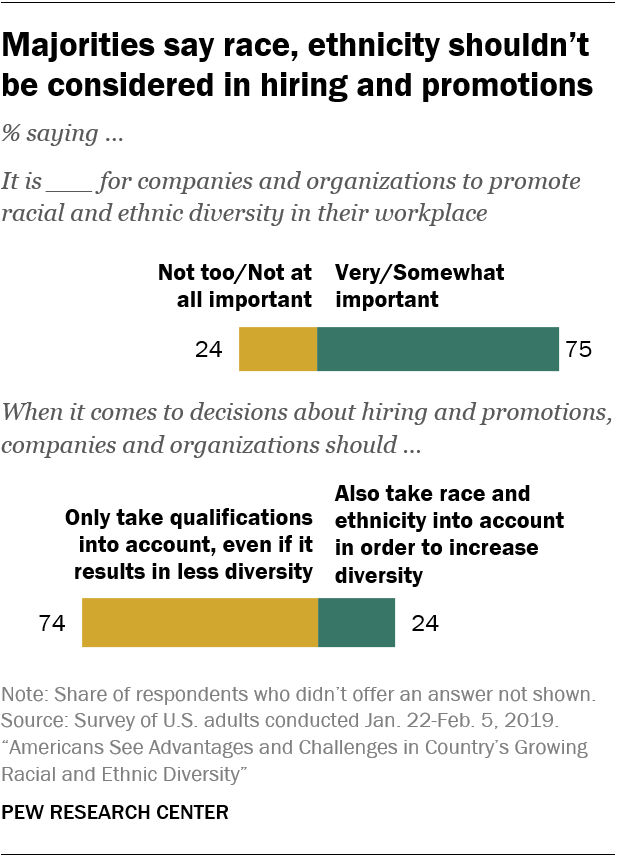 As the United States becomes more racially and ethnically diverse, and as companies from Wall Street to Silicon Valley grapple with how to build workforces that reflect these changing demographics, Americans have a complicated, even contradictory, set of views about the impact of diversity and the best way to achieve it. Most say it’s a good thing that the country has a diverse population, but many also say this introduces its own set of challenges. And while a majority values workplace diversity, few endorse the idea of taking race or ethnicity into consideration in hiring and promotions, according to a new Pew Research Center survey.
As the United States becomes more racially and ethnically diverse, and as companies from Wall Street to Silicon Valley grapple with how to build workforces that reflect these changing demographics, Americans have a complicated, even contradictory, set of views about the impact of diversity and the best way to achieve it. Most say it’s a good thing that the country has a diverse population, but many also say this introduces its own set of challenges. And while a majority values workplace diversity, few endorse the idea of taking race or ethnicity into consideration in hiring and promotions, according to a new Pew Research Center survey.
When it comes to diversity in the communities where they live, most U.S. adults (66%) – including a majority of those who live in neighborhoods with little diversity – are satisfied with the racial mix in their area. A majority (54%) says children should go to local schools, even if that results in most schools being less diverse. Fewer (42%) say children should go to schools that are racially and ethnically mixed, even if that means some students go to school outside of their local community.
Overall, white, black and Hispanic adults are about equally likely to say it’s good that the U.S. population is racially and ethnically mixed, and majorities across these groups say this has had a positive impact on U.S. culture. But black Americans place more value than whites and Hispanics on workplace diversity and school integration.
Opinions on these issues also vary considerably along party lines, with Democrats and those who lean to the Democratic Party more likely than Republicans and Republican leaners to express positive views of the importance and impact of racial and ethnic diversity. This is the case even after taking into account the differences in the racial composition of the two parties.1
These are among the key findings on views about diversity from a nationally representative survey of 6,637 U.S. adults conducted online Jan. 22-Feb. 5, 2019, in English and Spanish, using Pew Research Center’s American Trends Panel.2
These findings are part of a larger survey that also explores Americans’ attitudes about race relations and racial inequality and the role of race in people’s lives. For more, see “Race in America 2019.”
This survey includes an oversample of Asian respondents, for a total sample size of 332 Asians. The sample includes English-speaking Asians only and, therefore, may not be representative of the overall U.S. Asian population (66% of our weighted Asian sample was born in another country, compared with 78% of the U.S. Asian adult population overall).
Despite this limitation, it is important to report the views of Asians on race relations and racial inequality, as well as their personal experiences with racial discrimination, as the U.S. Asian population is growing faster than any other major racial or ethnic group. Measuring the attitudes of Asians on these topics is an important piece in understanding the state of race in America today.
As always, Asians’ responses are incorporated into the general population figures throughout this report; data are weighted to be representative of the U.S. adult population as a whole. Asians are shown as a separate group when a question was asked of the full sample. Because of the relatively small sample size and a reduction in precision due to weighting, results are not shown separately for Asians for questions that were only asked of a random half of respondents (Form 1/Form 2) or some filtered questions. We are also not able to analyze Asian respondents by demographic categories, such as gender, age or education.
More than half say racial and ethnic diversity is very good for the country
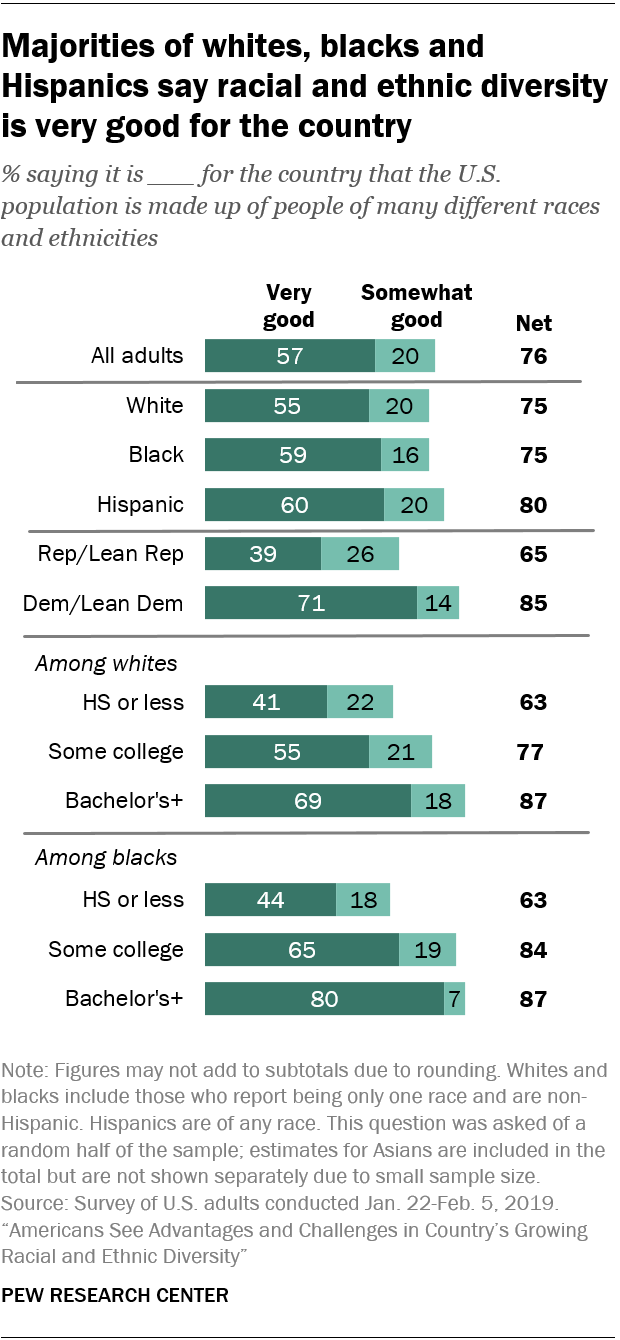 A majority of Americans (57%) say the fact that the U.S. population is made up of people of many different races and ethnicities is a very good thing for the country, and another 20% say this is somewhat good. Small shares say this is somewhat (5%) or very (1%) bad, while 17% say it is neither good nor bad for the country. Similar shares of whites (55%), blacks (59%) and Hispanics (60%) say racial and ethnic diversity is very good for the country.
A majority of Americans (57%) say the fact that the U.S. population is made up of people of many different races and ethnicities is a very good thing for the country, and another 20% say this is somewhat good. Small shares say this is somewhat (5%) or very (1%) bad, while 17% say it is neither good nor bad for the country. Similar shares of whites (55%), blacks (59%) and Hispanics (60%) say racial and ethnic diversity is very good for the country.
Whites and blacks with at least a bachelor’s degree are more likely than their less educated counterparts to say it’s very good for the country to be made up of people of many races and ethnicities. About seven-in-ten whites with a bachelor’s degree or more education (69%) say this, compared with 55% of whites with some college and 41% of those with a high school diploma or less education. Among blacks, 80% with at least a bachelor’s degree say it’s very good that the country is racially and ethnically mixed; a smaller majority of blacks with some college (65%) and 44% of those with less education say the same. The link between education and views of diversity is less clear among Hispanics.
Across party lines, majorities of Democrats and Republicans say it’s at least somewhat good that the U.S. population is racially and ethnically mixed, but Democrats are far more likely to say this is a very good thing (71% vs. 39% of Republicans). Among Democrats, whites are more likely than blacks to say diversity is very good for the country (76% vs. 61%); 67% of Hispanic Democrats say the same.3
Most see diversity having a positive impact on the country’s culture
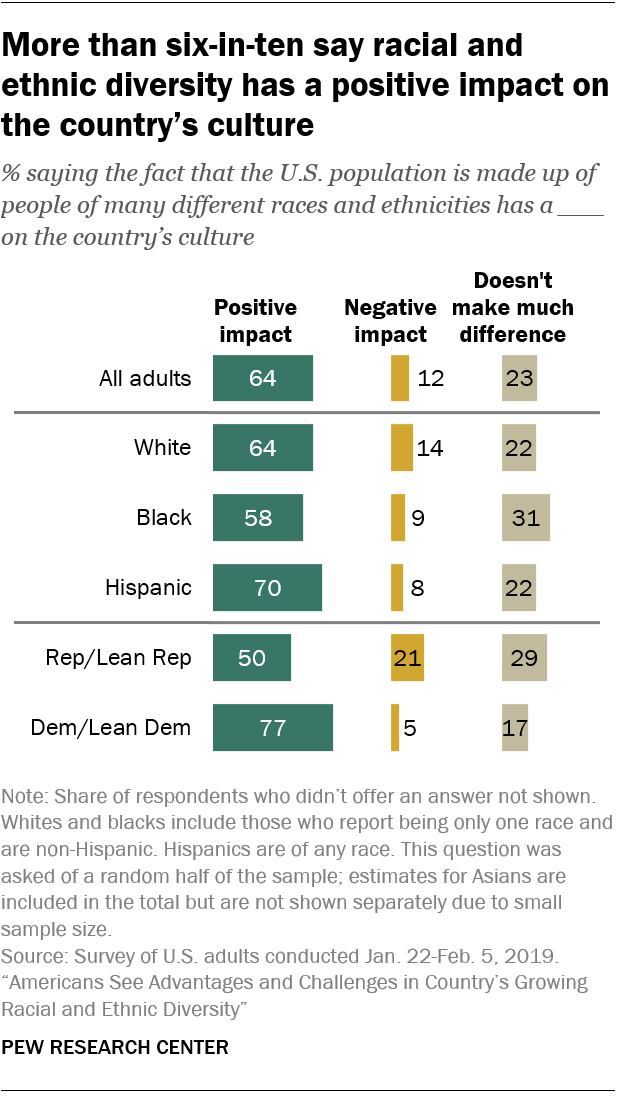 More than six-in-ten Americans (64%) say the fact that the U.S. population is made up of people of many different races and ethnicities has a positive impact on the country’s culture; 12% say it has a negative impact and 23% say it doesn’t make much difference. Hispanics (70%) are more likely than whites (64%) and blacks (58%) to say the country’s racial and ethnic diversity has a positive impact on the country’s culture, although majorities across all three groups say this is the case.
More than six-in-ten Americans (64%) say the fact that the U.S. population is made up of people of many different races and ethnicities has a positive impact on the country’s culture; 12% say it has a negative impact and 23% say it doesn’t make much difference. Hispanics (70%) are more likely than whites (64%) and blacks (58%) to say the country’s racial and ethnic diversity has a positive impact on the country’s culture, although majorities across all three groups say this is the case.
This view is widespread among Democrats, and particularly white and Hispanic Democrats. Fully eight-in-ten white Democrats (84%) and about three-quarters of Hispanic Democrats (76%) say this diversity has a positive impact on U.S. culture, compared with 60% of black Democrats.
Among Republicans, half say the fact that the U.S. population is made up of people of many different races and ethnicities has a positive impact on the country’s culture; about one-in-five (21%) say it has a negative impact (29% say it doesn’t make a difference).
While most Americans say having a population that is racially and ethnically mixed enhances U.S. culture, views are more negative when the public is asked about the prospect of blacks, Hispanics, Asians and other racial minorities making up a majority of the population (which the U.S. Census Bureau projects will happen by the year 2050). In a separate survey conducted in December 2018, more said having a majority nonwhite population will weaken American customs and values (38%) than said it will strengthen them (30%); 31% said this won’t have much of an impact.
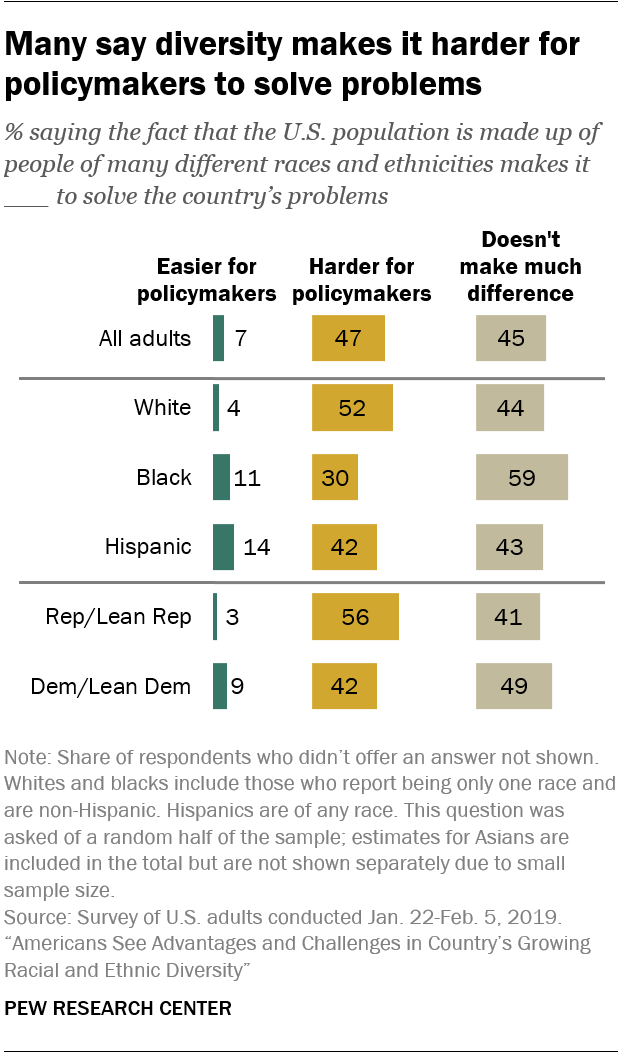
Despite generally positive views of diversity, many say it poses challenges for policymakers
A sizable share of Americans (47%) say having a population that is made up of people of many different races and ethnicities makes it harder for policymakers to solve the country’s problems; a small share (7%) say it makes it easier for policymakers and 45% say it doesn’t make much difference. Whites (52%) are more likely than Hispanics (42%) and blacks (30%) to say the country’s diversity makes it harder for policymakers to solve problems.
There are also partisan differences on this question, with Republicans more likely than Democrats to say the country’s racial and ethnic diversity poses challenges for policymakers (56% vs. 42%). Democrats are more likely to say it doesn’t make much difference in this regard.
Broad support for workplace diversity, but most say applicants’ race and ethnicity should not be a factor in hiring and promotions
 Three-quarters of Americans say it is very (49%) or somewhat (26%) important for companies and organizations to promote racial and ethnic diversity in their workplace. Blacks are particularly likely to say this is very important: 67% say this, compared with 52% of Hispanics and 43% of whites. And as is the case in views about the impact diversity has on the country overall, Democrats are far more likely than Republicans to say it’s very important for employers to promote racial and ethnic diversity in their workplace (64% of Democrats vs. 29% of Republicans). These partisan differences remain when looking only at those who are white.
Three-quarters of Americans say it is very (49%) or somewhat (26%) important for companies and organizations to promote racial and ethnic diversity in their workplace. Blacks are particularly likely to say this is very important: 67% say this, compared with 52% of Hispanics and 43% of whites. And as is the case in views about the impact diversity has on the country overall, Democrats are far more likely than Republicans to say it’s very important for employers to promote racial and ethnic diversity in their workplace (64% of Democrats vs. 29% of Republicans). These partisan differences remain when looking only at those who are white.
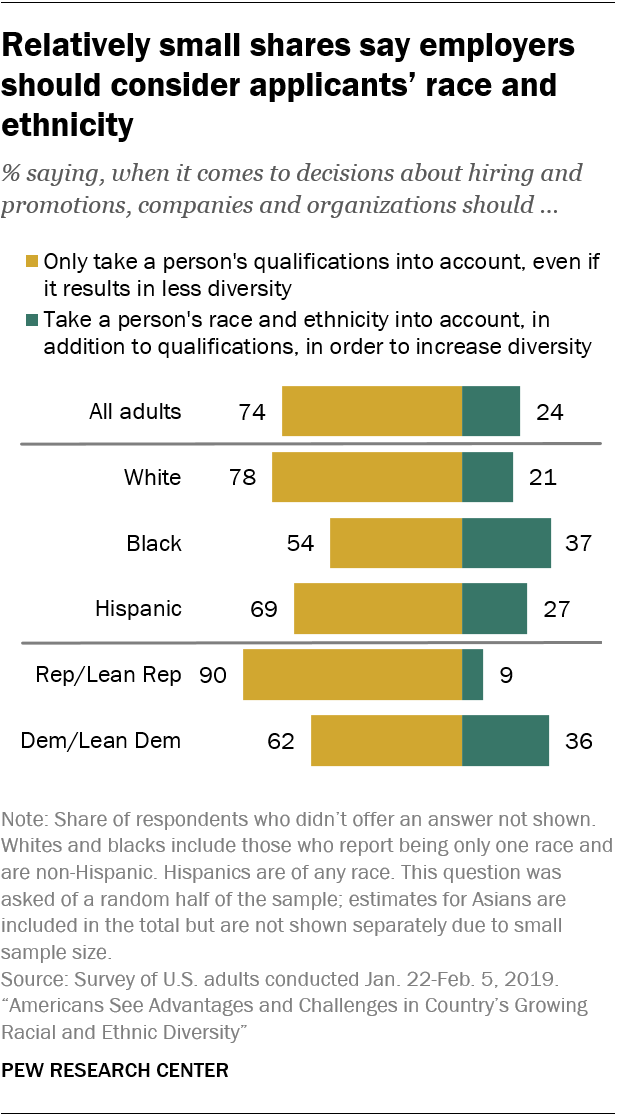
While most Americans say it’s at least somewhat important for companies and organizations to promote racial and ethnic diversity, only about one-in-four (24%) say that, in addition to their qualifications, a person’s race and ethnicity should be considered in decisions about hiring and promotions in order to increase diversity. A majority (74%) says employers should only take a person’s qualifications into account when making these decisions, even if it results in less diversity in the workplace.
The view that employers should only take a person’s qualifications into account is widespread among whites (78%) and Hispanics (69%); about half of blacks (54%) share this view.
Republicans are much more likely than Democrats to say a person’s race and ethnicity shouldn’t be a part of hiring and promotion decisions. Even so, majorities of both groups (90% vs. 62%) hold this view. Again, this partisan difference is nearly unchanged among whites.
Whites, blacks differ on the importance of students going to a racially and ethnically mixed school vs. going to a school in their local community
Mandatory busing programs aimed at desegregating schools ended years ago, but the issue of school integration remains a topic of debate in many parts of the country.
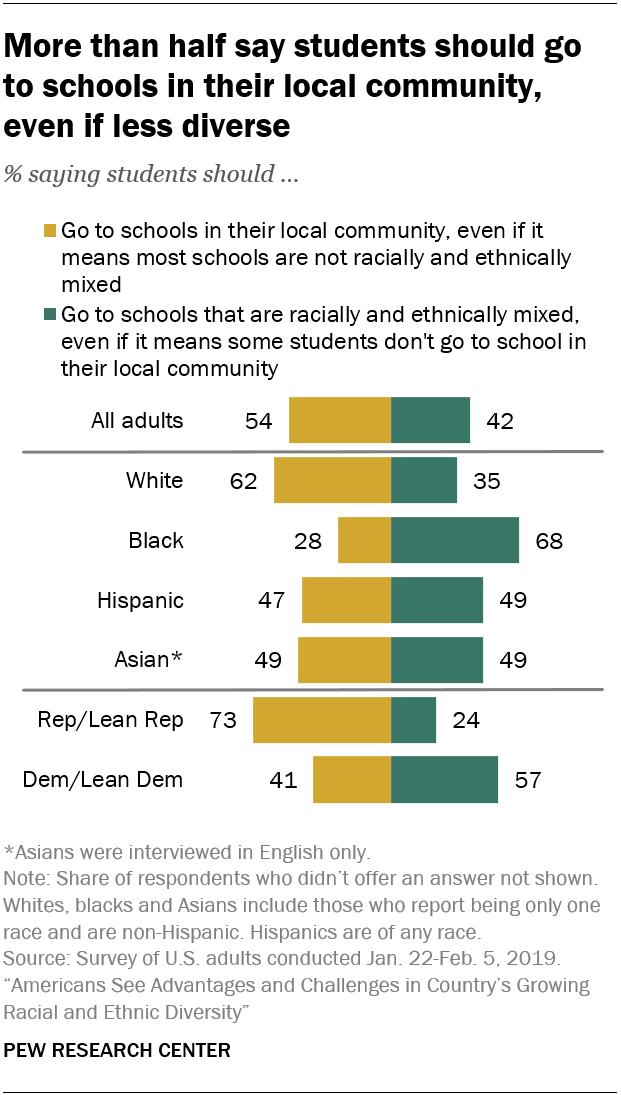 Today, more than half of Americans (54%) say students should go to school in their local community, even if it means that most schools are not racially and ethnically mixed; 42% say students should go to schools that are racially and ethnically mixed, even if it means that some students don’t go to school in their local community.
Today, more than half of Americans (54%) say students should go to school in their local community, even if it means that most schools are not racially and ethnically mixed; 42% say students should go to schools that are racially and ethnically mixed, even if it means that some students don’t go to school in their local community.
Black and white adults have widely different views on this. Most whites (62%) say students should attend schools in their local community, even if most schools are less diverse as a result. In contrast, about seven-in-ten blacks (68%) think students should go to schools that are racially and ethnically mixed, even if they’re not in their local community. Hispanics and Asians are about evenly divided on this issue.
Views also differ considerably along party lines, with 73% of Republicans – vs. 41% of Democrats – saying students should go to school in their local community, even if it means most schools are not racially and ethnically mixed. Black Democrats (71%) are far more likely than their white (52%), Hispanic (56%) and Asian (55%) counterparts to say students should go to schools that are racially and ethnically diverse, even if it results in some students not going to their local schools.
About a quarter of Americans wish their local community was more racially and ethnically mixed
 Most Americans (66%) are satisfied with the racial mix in the community where they live; 24% wish their community was more racially mixed and 8% wish it was less so.
Most Americans (66%) are satisfied with the racial mix in the community where they live; 24% wish their community was more racially mixed and 8% wish it was less so.
For whites and Hispanics, views about the racial mix in their community are strikingly consistent regardless of how diverse the community is. In this analysis, diversity is measured in terms of the share of a neighborhood’s population in its largest racial or ethnic group.4 For example, a neighborhood that is 80% white (largest group), 10% Hispanic, 5% black and 5% Asian is considered less diverse than one that is 20% white, 60% Hispanic (largest group), 5% black and 15% Asian. The least diverse neighborhoods are those where 90% or more of the residents are part of the largest racial or ethnic group; the most diverse are neighborhoods where fewer than half of the residents are in the largest group.
About seven-in-ten whites – and about six-in-ten Hispanics – in the most and least diverse neighborhoods say the community where they live is as racially mixed as they’d like it to be. Among blacks, those in the least diverse neighborhoods are less satisfied with the racial mix in their communities.
The vast majority of whites who live in neighborhoods with very little diversity are surrounded by other whites. By contrast, for blacks who live in less diverse areas, their neighborhoods are less likely to be made up predominantly of black residents. Among black respondents, 63% of those in areas where 80% or more are in the largest racial or ethnic group are in majority black communities; 34% are in neighborhoods that are predominantly white. A large share (82%) of Hispanics who live in less diverse neighborhoods reside in predominantly Hispanic communities.
Among whites in the least diverse neighborhoods, Democrats, college graduates and those younger than 30 are less satisfied with their community’s racial mix
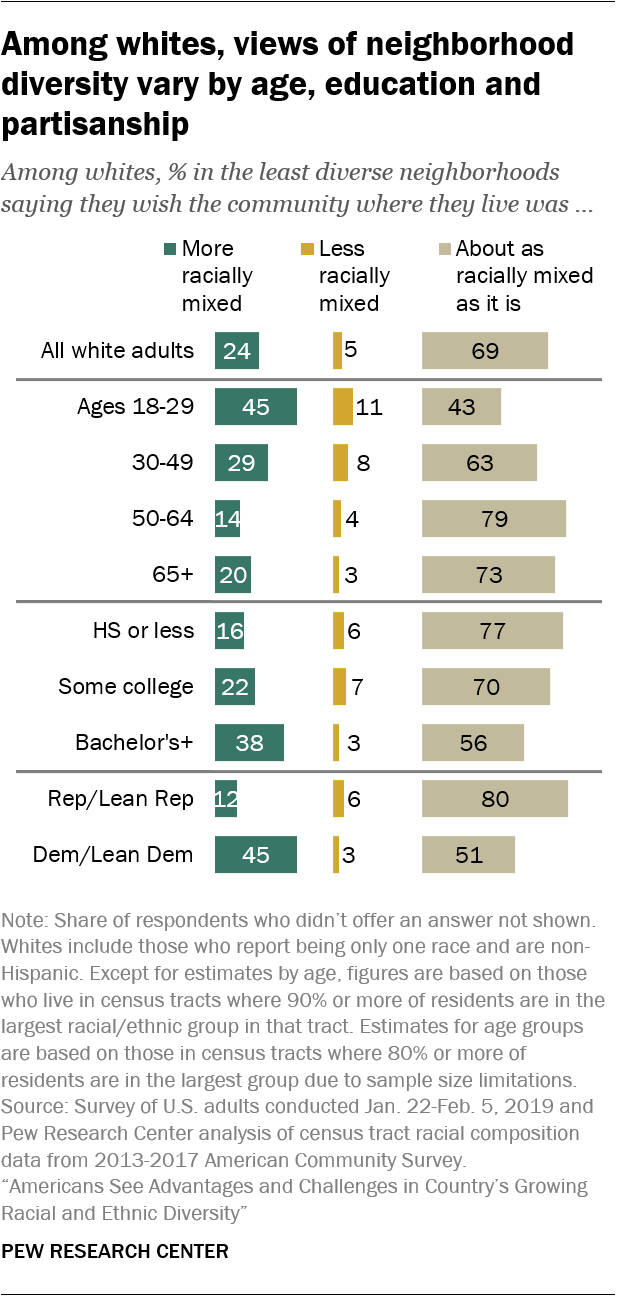 Outlooks on community diversity vary considerably between white Democrats and white Republicans. Among white Republicans in the least diverse neighborhoods, 80% are satisfied with the amount of racial diversity in their community. White Democrats in this type of neighborhood are more divided: 51% say their community is as racially mixed as they’d like it to be and 45% wish it was more so.
Outlooks on community diversity vary considerably between white Democrats and white Republicans. Among white Republicans in the least diverse neighborhoods, 80% are satisfied with the amount of racial diversity in their community. White Democrats in this type of neighborhood are more divided: 51% say their community is as racially mixed as they’d like it to be and 45% wish it was more so.
Age and educational attainment are also related to these attitudes: In neighborhoods with little diversity, whites younger than 30 are far less satisfied with the racial mix in their community than older whites. About four-in-ten white young adults in some of the least diverse neighborhoods say their community is as racially mixed as they’d like it to be (43%), while a similar share (45%) wish it was more racially mixed. In contrast, most whites ages 30 to 49 (63%), 50 to 64 (79%) and 65 and older (73%) are satisfied with the racial mix in their community.5
Among whites with a bachelor’s degree or more education, 38% in the least diverse neighborhoods say they wish their community was more racially mixed than it is; 22% of those with some college and 16% with a high school diploma or less education say the same. Still, at least half in each group say their community is about as racially mixed as they would like it to be.
Relatively few Americans interact a lot with people from other racial and ethnic groups
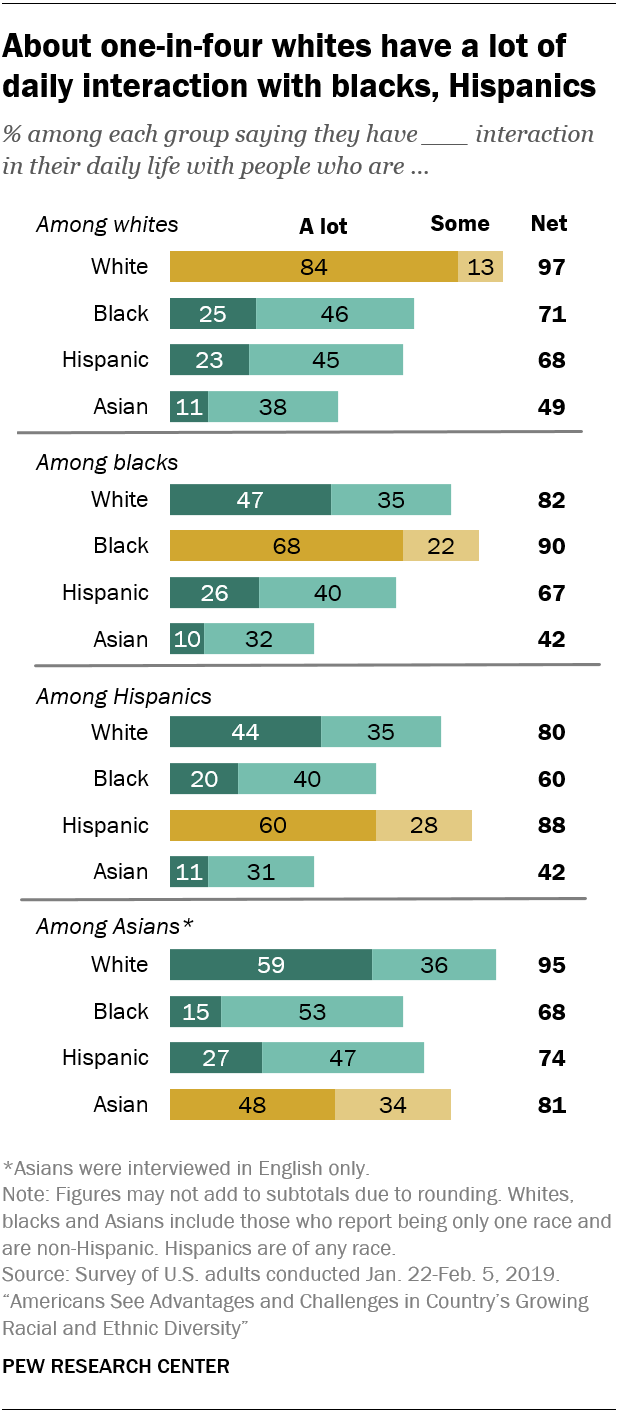 Most Americans have at least some daily interaction with people who do not share their race or ethnicity, but relatively small shares say they have a lot of interaction. This is particularly the case for whites interacting with racial or ethnic minorities and nonwhites interacting with minority groups other than their own.
Most Americans have at least some daily interaction with people who do not share their race or ethnicity, but relatively small shares say they have a lot of interaction. This is particularly the case for whites interacting with racial or ethnic minorities and nonwhites interacting with minority groups other than their own.
About a quarter of white adults say they interact with blacks (25%) and Hispanics (23%) a lot in their day-to-day life. Among blacks, 26% say they have a lot of interaction with people who are Hispanic, while one-in-five Hispanics say they have frequent interaction with people who are black. About one in-ten whites, blacks and Hispanics say they interact with Asians a lot in their daily life.
A majority of Asians (59%) say they have frequent daily interaction with whites, more than the share of blacks (47%) and Hispanics (44%) who say the same. About one-in-four Asians (27%) say they have a lot of interaction with people who are Hispanic and 15% say the same about people who are black.
Asians (48%) are less likely than whites (84%), blacks (68%) and Hispanics (60%) to say they have a lot of interaction with people in their own group. The extent to which Americans interact with various racial or ethnic groups reflects, at least in part, the shares of each group in the population.
About three-in-ten Americans say it would bother them to hear people speak a language other than English in public
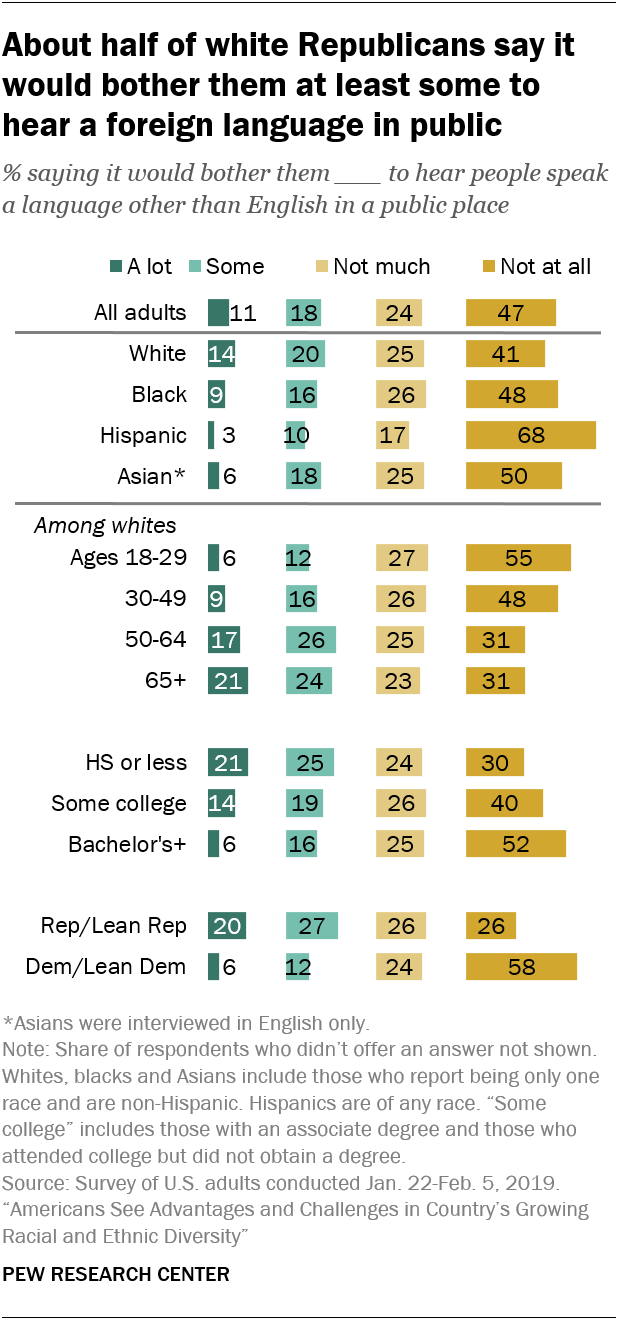 Most Americans (70%) say they would not be particularly bothered if they heard people speak a language other than English in a public place, including 47% who say they would not be bothered at all. Still, a sizable share (29%) says this would bother them at least some.
Most Americans (70%) say they would not be particularly bothered if they heard people speak a language other than English in a public place, including 47% who say they would not be bothered at all. Still, a sizable share (29%) says this would bother them at least some.
Roughly a third of whites (34%) and about a quarter of blacks (24%) and Asians (24%) say they would be bothered if they heard people speak a language other than English in public; a smaller share of Hispanics (14%) say the same. About two-thirds of Hispanics (68%) say this wouldn’t bother them at all, compared with half or fewer whites (41%), blacks (48%) and Asians (50%). Foreign-born Hispanics are more likely than those born in the U.S. to say they would not be bothered at all if they heard someone speak a language other than English in public (76% vs. 61%).
Among whites, reactions vary considerably by age, education and political orientation. Younger whites and those with a bachelor’s degree or more education are less likely than their older and less educated counterparts to say they would be bothered by hearing a language other than English in a public place.
Views are even more divided along partisan lines. About six-in-ten white Democrats (58%) – vs. 26% of white Republicans – say this wouldn’t bother them at all.
References to whites, blacks and Asians include only those who are non-Hispanic and identify as only one race. Hispanics are of any race.
All references to party affiliation include those who lean toward that party: Republicans include those who identify as Republicans and independents who say they lean toward the Republican Party, and Democrats include those who identify as Democrats and independents who say they lean toward the Democratic Party.
References to college graduates or people with a college degree comprise those with a bachelor’s degree or more. “Some college” includes those with an associate degree and those who attended college but did not obtain a degree. “High school” refers to those who have a high school diploma or its equivalent, such as a General Education Development (GED) certificate.
Foreign born refers to people born outside of the United States, Puerto Rico or other U.S. territories to parents neither of whom was a U.S. citizen, regardless of legal status.
U.S. born refers to individuals who are U.S. citizens at birth, including people born in the United States, Puerto Rico or other U.S. territories, as well as those born elsewhere to parents who were U.S. citizens.


